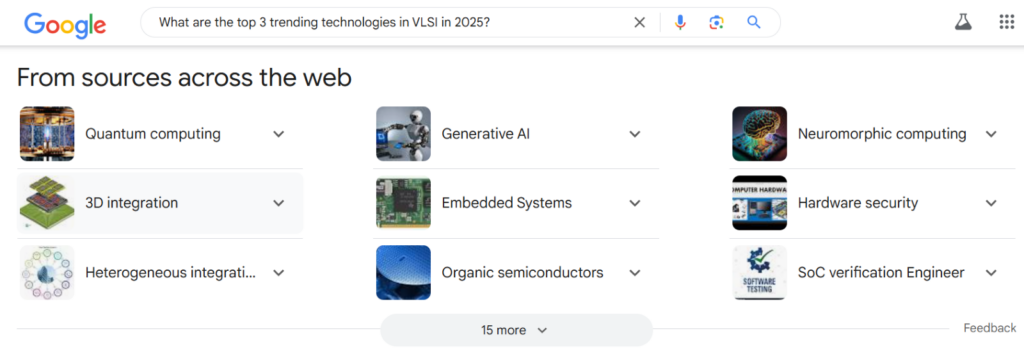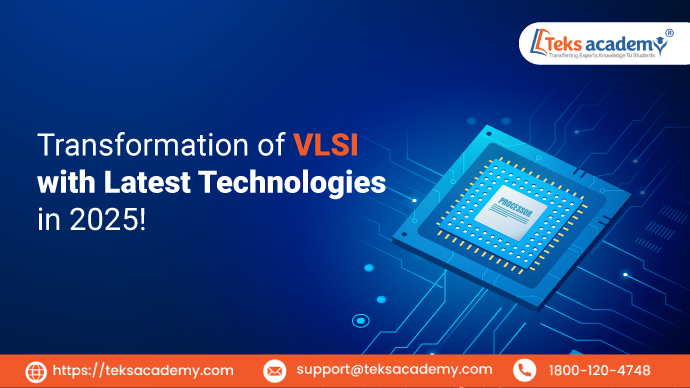In 2025, there is a huge transformation in the semiconductor industry. Each day we rely on electronic technology. But how this electronic technology is being advanced? Now the VLSI will come into picture. It plays a vital role in the development of modern electronic systems. According to Gartner reports, now the global semiconductor market is going to reach $721 billion. As industries mostly prefer this technology, it will be a great choice to take-up the best VLSI training.
In this blog, let us explore the overview of VLSI, importance of VLSI in modern days, and its latest technologies that are revolutionizing the electronic industry.
Overview of VLSI:
Very large-scale integration is a process of designing the integrated circuits (IC’s). It integrates millions or even billions of transistors onto a single chip. Because of this, it is possible to create tiny, quick, and more efficient electronic devices. It stands out as the backbone of the modern semiconductor industry.
Mostly the industries are looking for higher performance, lower power consumption, and miniature devices. Thus, VLSI will continue to evolve with more advancing technologies. Here are the top industries that benefits from VLSI are:
- Consumer electronic industry that manufactures smartphones, laptops, etc.
- Automotive industry which produces advanced driver assistance systems and also self-driving vehicles.
- Used in healthcare and medical devices like MRI scanners and AI driven diagnostics.
Now let us explore the key reasons why VLSI is essential in these modern days:

Miniaturization and High-Performance devices:
Current VLSI technological trends will enable faster processing speed and reduce the size of electronic devices. This technology is used to design portable devices like tablets and smartwatches. Because of these integrations the number of components is reduced and simplifies the complex tasks.
Power Efficiency and Sustainability:
The advanced VLSI designs will optimize power consumption. So that efficiency can be increased through the techniques like:
- Low – power design architectures will reduce the waste in processors.
- Dynamic voltage scaling that adjusts power consumptions.
- Use energy-efficient semiconductor materials that extend battery life.
5G and High-Speed Computing:
The 5G networks and high-performance computing will mostly depend on VLSI technology. The modern 5G chips are designed which enables ultra-fast wireless communications. Not only this, the advanced processors and GPUs are also designed in order to support cloud computing.
What are the latest technologies in VLSI?
VLSI is not just about making the chips smaller but to make the electronic devices more efficient. Now-a-days semiconductor industry is evolving with advanced technologies. What are the top 3 trending technologies in 2025? Let us know:

Image source: Google
- AI and Machine learning in VLSI designing
- Neuromorphic Computing
- Quantum Computing
AI and Machine learning in VLSI designing:
AI and ML are technologically revolutionizing the chip design processes. These technologies are integrated to designing tools to optimize performance and reduce power consumption.
The AI algorithms are used in performing tasks such as floor planning, routing, and optimizing chip layouts for maximum efficiency. Whereas the best ML techniques will analyze vast data sets. It helps in identifying the patterns, trends, and enables smarter design decisions.
Benefits:
- Speeds up the chip designing.
- Reduces human errors in layouts.
- Minimize the design iterations and manufacturing defects.
Neuromorphic Computing:
Neuromorphic computing is the cutting-edge trend in VLSI technology. It relates the architecture and functionality of the human brain to revolutionize computing. It offers highly scalable tasks like pattern recognition and adaptive learning. This emerging technology will transform various industries from healthcare to robotics to make real-time decision making.
What are the benefits of neuromorphic computing?
- Performs the tasks faster and consumes less energy.
- Run multiple tasks simultaneously.
- Improves efficiency.
Quantum Computing:
Quantum computing is the latest VLSI technology of the semiconductor industry. It uses the principles of quantum mechanics and quantum processors. Because of these, it will solve the complex problems faster than traditional computers. Companies mostly explore the applications of quantum computing in areas such as cryptography, optimization, and simulation.
Benefits:
- Reduces the design time and speeds up the circuit simulations.
- Quickly identify the manufacturing defects.
- Develops new semiconductor materials for next-gen chips.
Final Thoughts:
In the end, we can say it is very important to stay updated with the latest technologies. It is the trending field of innovations and growth. Today the semi-conductor industry will present abundant opportunities. By continuously updating your skills will make you stand forefront in this innovative field.

